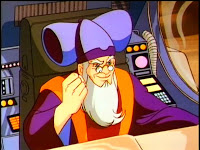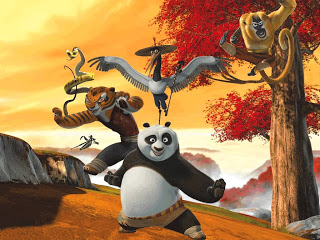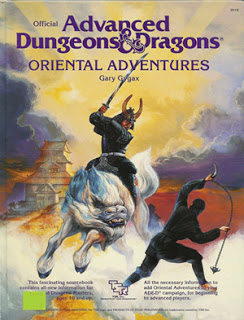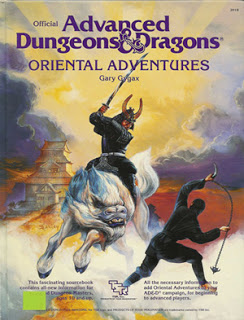I was as thrilled as anyone in 1985 when I got my copy of Oriental Adventures. And instantly a group of NPC adventurers from the West showed up in my Greyhawk campaign for a few sessions, then faded away. I put an OA adventuring party in my Castle of the Mad Archmage, just to spice things up, as well. But on the whole the published OA book was kinda… meh. And I think I know why.
First, it’s filled with terms that nobody either recognizes nor understands. Quick! Which of these lives in the water: hai nu, hsing-sing, con-tinh, or bisan? No offense intended to anyone, but the names of the monsters are largely gibberish to dumb Americans like me, and I think that went a ways towards making them less approachable and ultimately less used. Yes, there are goblin spiders and gargantuas (Godzilla and King Kong), but they’re a distinct minority.
Now, when you come to the character classes, it gets much better, but there are still things left to be desired. You know what a samurai, a ninja, a yakuza, and a ronin are. Wu jen? Yeah, I can internalize one more class name, and I think I’ve heard that somewhere else before. Shukenja? Is that the cleric analogue or something else? Sohei? Um… is that the cleric analogue or something else? Is a bushi a fighter? Are there even “just fighters” in an OA game?And a kensai is something like a cavalier, right? But isn’t that what a samurai is supposed to be? And why are they all Japanese?
 |
| This guy was a Wu Jen, right? |
There’s points one and two: make it accessible to dumb Americans like me. And make it broader than just medieval Japan.
The good news is that this work is largely done, although not in game format. There are two distinct genres of film that could be mined here: chanbara and wuxia. They are, respectively, samurai movies and kung-fu movies, and they have very distinctive tropes that identify them as such. Any setting or set of rules that would attempt to portray an oriental-based fantasy game would need to have those genres firmly in mind, because they define “eastern” fantasy as Conanesque “Swords and Sorcery” and Tolkeinesque “High Fantasy” define Western fantasy.
And that’s point three; it shouldn’t just be Dungeons and Dragons with new classes and spells. It should be oriented (pun intentional) towards the specific cultural tropes that define chanbara and wuxia. Where swords and sorcery has its standard themes of a morally apathetic universe, barbarian outsider vs. corrupt civilization, and small-scale stakes, and high fantasy has its themes of universal good vs. evil, everyman-evolving-into-hero, and familiar-world-with-a-twist setting, we see chanbara as exploring the theme of duty vs. morality, the code of bushido, and “invented tradition” that goes beyond the historical model. Wuxia is quite distinct from this, featuring the xia code (roughly a Chinese equivalent of chivalry or bushido), personal loss leading to personal growth (usually through intense martial arts training), and a setting that is at its core corrupt, requiring the administration of law and justice to be handled by heroes because such things are beyond the vast corrupt and distant bureaucracy of government.
 |
||||||
| Actually a fair representation of Wuxia-style film. No joke. |
The point being that there’s a huge well of well-established mythology (in bonus visual format) there that’s at least somewhat accessible to dumb Americans like me. It’s obviously not going to be historical, but it’s exciting and accessible. Like Excalibur or Conan.
I should point out that Bollywood also provides a similar framework for yet a third genre of Indian-based non-European fantasy; complicated love triangles (often including long-lost relatives), unrepentant villains who are villains for the sake of being villains, and a self-conscious mixture of action, comedy, and Broadway-style dance numbers. Well, maybe that last doesn’t have too much application in gaming…











I don't know about that, my character didn't take all those skill points in Perform(Dance) for nothing! ;P
Great article Joe! I do fondly remember trying to muddle through OA with only American Ninja movies as my frame of reference. Obviously eastern cinema has caught up to the US significantly since OA was released. In a similar vein I knew zilch about middle-eastern culture making Al Qadim a hard setting to run as well. Now of course, it's hard not to get ME culture everyday in our newspapers. 😛
Hmm. I'm torn in regards to your assessment. I think you're correct in a way, but I'm actually rather glad that OA wasn't written for "dumb Americans." Rather, it seemed to be for Westerners with either some knowledge of Chinese/Japanese culture and mythology or at least the drive to do some reading and acquire some. I like that it doesn't talk down to the reader.
And is that really wrong? I don't think so. Sure, a game based on the simpler, better-known worlds of Asian action cinema can be fun and perfectly valid, but must a game always embrace "accessability uber alles" to be worthy of existence?
Have you checked out Flying Swordsmen yet? I like that it's based on Chinese rather than Japanese cultures.
Ha, Black, I was just going to post that: http://lordgwydion.blogspot.com/p/flying-swordsmen-rpg.html
Oriental Adventures was always a poor runner-up to FGU's "Bushido." That was a great game but OA just seemed to lack something gripping. It did try to cover too much cultural ground and ended up doing it poorly, I thought. I know the econimic reasons it was put out when it was but things would've been better if T$R had done a Japanese based supplement and a Chinese based one (and maybe a Korean one, too).
Will, I'd turn your comment around and mesh it into Gray Mouser's. Just as "standard" D&D isn't for people who've read "Tristan and Isolde" and Geoffrey of Monmouth, I would say that an oriental supplement for it shouldn't assume the reader was all that familiar with real oriental culture. For those people, I'd point them to a game like Bushido, which I've played and enjoyed greatly.
We loved OA when it came out, and played often given our usual rotation of games and GM's. Not that we wouldn't have cheerfully accepted more classes and diversity, but we had no problems with picking up a new set of terms. Bushido on the other hand was a bit too much for us, although we appreciated the work put into it. I have Chaosium's Land of Ninja, and Celestial Empire, and both are a lot of fun.
Vulma and Orc, I downloaded it, but haven't read it yet.
I have played a lot of OA over the years. I am even working on the "fixes" for it now. I don't think it's for everyone, I do think it falls somewhere between Bushido and standard AD&D for it's audience. It's appeal is mostly for people that want to play AD&D, but in a fantasy east-Asia-in-a-blender setting. I think it actually could have done better to focus more strongly on trying to adhere to one culture or genre rather than trying to capture the feel of wuxia and chanbara and ninja movies at the same time, those are incompatible goals. They also tried to throw in at least a little bit of all of east Asia from Mongolia and Korea to Vietnam and the Philippines, but the primary sources were Japan, then China. I have done a bit of digging around trying to seek out the history of this book, since it introduced so much to 1st edition AD&D and all I have come up with are mostly rumors.
Do you have any specific questions, William? I (or someone else here) might have some answers, with references.
Hurrah for AD&D OA!
I think, like Gray Mouser says, OA was following in the footsteps of FGU's Bushido, and certainly needed to avoid negative comparisons of being "Bushido Lite". OA came out after Unearthed Arcana and so AD&D was already going through revision, and lord knows it had to be an improvement upon yet another Eastern weapons or Ninja class articles in Dragon / White Dwarf / Imagine et al. I only bought the Bushido PDF the other day and already I'm lost in the all of the culture rich references. At least AD&D called Honour "Honour" and not "On". I totally agree with you that it seems too closely tied with Japan – but maybe this also demonstrates how stupendously generic the rest of D&D was. With regards to remembering the differences between the monsters, I think more illustrations would have helped. I knew players who didn't really know the difference between the Dryads and Nereids, but after the looking at the pictures they certainly remembered which one was in the water.;) I love the completeness of OA – but it seriously needed more illustrations and not just historical royalty free art. I've spent my life knowing cheap artists so I never understand why cost there would be a big issue. As I struggle through reading Bushido, I'm reminded that I a while back I pledged my loyalty to S&W Whitebox based Ruins & Ronin (+ninja class supplement) but I'd add a honour system and use AD&D OA and Bushido as a resource for ideas (and weapon pictures!).
Ah damnation you used a picture from Jayce and the Wheeled Warriors…
"There's a power that comes from deep inside of you. Cause every day you're reaching toward the light
And you know there's a long long way ahead of you. But when your wheels get you there, things will turn out right!"
That's only going to be stuck in there for a few hours.
I should probably don my flame proof overalls when I say this, but . . .
I don't think I see a whole lot of value coming out of an Oriental Adventures style supplement. I, personally, never saw the allure of it and, for the most part, relegated it to the stack of things that Nippono-philes gushed over, or ranted over depending on the flavor.
One doesn't need rules to play in an asian themed campaign. As you point out yourself, Joe, what you really need is a phamphlet covering the basics. A glossary of terms, a few pages describing culture and honor and the like, which can be done for Japanese, Chinese, Indian, assorted "other" cultures of the region, and the rules can go take a flying leap as far as I'm concerned.
Let's face it, for the most part, you have everything you need to run a campaign of samurai and ninja already in the core books. The PHB only needs a very light reskinning, which can be done in a matter of a few pages, to fit the bill. Fighters are now called Samurai or Bushi or whatever. Ninja would probably be thieves or multi-classed if demi-humans. IMO, that's all you need and you'd be much better served with some insightful guidance on how to play in such a unique culture rather than handing out rules that pretend to emulate the world for people who don't actually know much (or anything) about it.
I basically agree with Hamlet; [i]Oriental Adventures[/i] failed because it was too different from [i]Dungeons & Dragons[/i], not because it failed to harness existing unexplored genres.
I think you nailed it on at least two points. When I first got OA back in the day, its glossary was too opaque and I just didn't have the cultural base to know what to do with it.
When I explored the possibility of running OA last year, now that my group and I have watched an Asian film every week for the past 3 years (Kung Fu Fridays, we call it), I found it focused too much on Japanese tradition and far from enough on other cultures, China especially. And wuxia is much more interesting to us than chambara is.
These concerns outweigh any system concerns I might have had (does AD&D achieve the right tone? etc.). Each time, other problems stopped me from using it before I could evaluate the system.